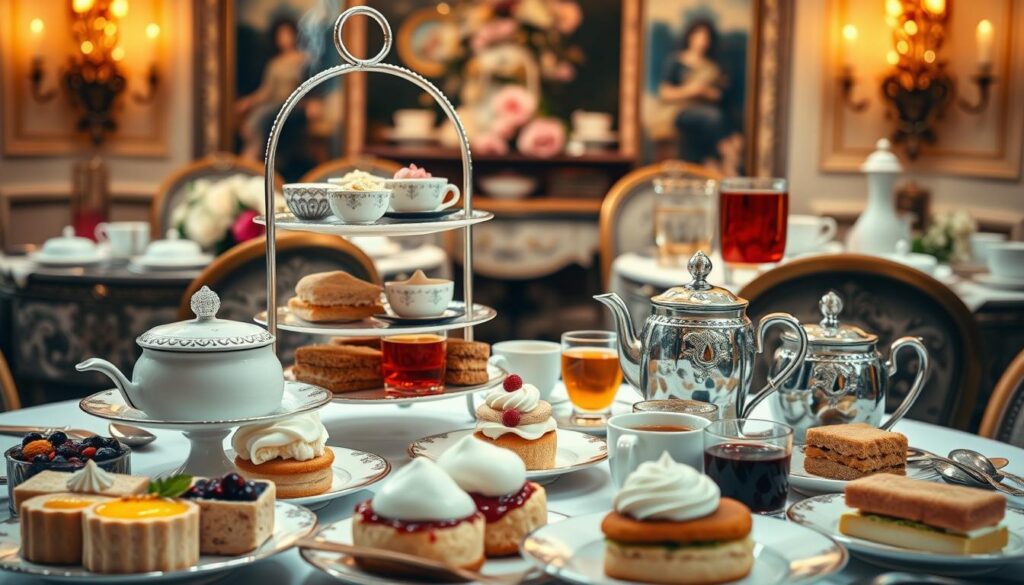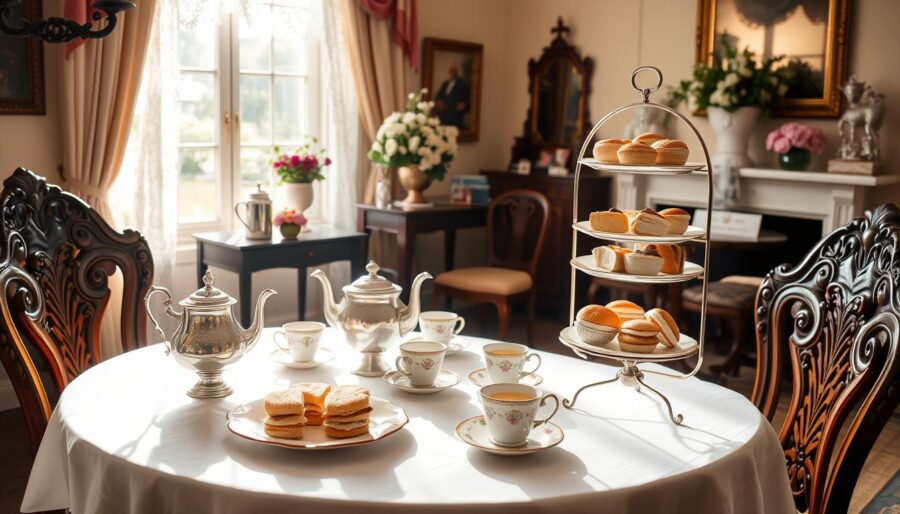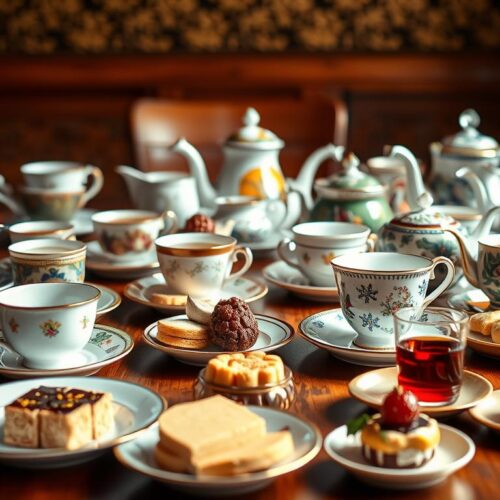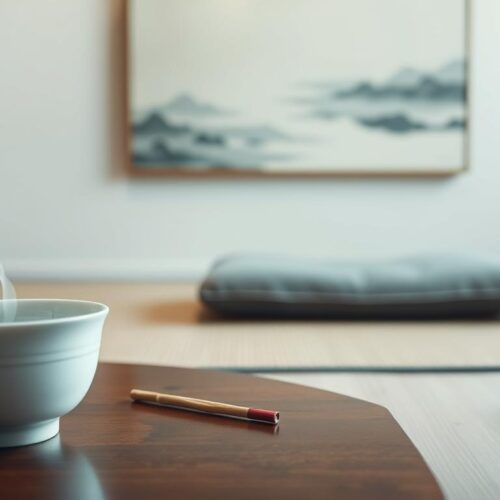Welcome to the world of British afternoon tea. This tradition delights the taste buds and shows off England’s rich tea culture. It started in the early 1840s as a social break between lunch and dinner. This gracious habit echoes elegance and hospitality.
Anna, the Duchess of Bedford, began this custom to cure late afternoon hunger with tea and snacks among friends. As you dive into the history of afternoon tea, you will see its lavish scones and pastries. You’ll also note the elegant tea rooms and homes where it’s enjoyed. Through this, you’ll understand why it’s a cherished tradition in British society.
Introduction to British Afternoon Tea Etiquette
British afternoon tea etiquette includes many customs for a special gathering. It involves knowing how to act gracefully and showing proper manners. You should respect the host and the long-standing British tea traditions.
When you go to an afternoon tea, warmly greet the host and sit where they say. These actions show you understand the etiquette. Keeping calm while enjoying the tea respects this tradition. Knowing how to make your tea right and when to add milk makes the experience better.
By following the tea rules, you enjoy the tasty flavors and good company. Afternoon tea is about more than food. It’s about polite talk and enjoying time with others.
The Origins of Afternoon Tea
The origins of afternoon tea began in the 1840s in England. Anna, the Duchess of Bedford, came up with the idea. At that time, Victorian tea customs were changing. The Duchess felt hungry in the late afternoon because lunch and dinner were far apart.
She started inviting friends over for tea and light snacks, like sandwiches and pastries. This get-together quickly became a popular social event among the upper class. What started as a simple fix for hunger turned into a well-loved tradition among the elite.
The concept of afternoon tea started to spread beyond the wealthy. Tea rooms popping up in cities made this experience accessible to more people. Over time, afternoon tea became an important part of British culture. It marked a shift in Victorian society and is still beloved in Britain today.
Different Types of Afternoon Tea
Afternoon tea today has a lot of different styles for everyone’s taste and occasion. The classic afternoon tea is famous. It offers scones, finger sandwiches, and many pastries on a beautiful tiered stand. This elegant setup invites you to try a little of each delight.
Cream tea is another lovely variation. It mainly presents scones with clotted cream and jams, with tea to drink. This type of tea is perfect for a chill day or spending time with friends.
For special occasions, there’s champagne afternoon tea. It adds a sparkle to the usual afternoon tea with some bubbly. Celebrating big moments with this version makes them even more memorable. It mixes the pleasure of afternoon tea with the joy of sparkling wine.
Knowing about these afternoon teas deepens your love for this tradition. Each one shows a different side of British food culture.

Essential Etiquette for Dining
Afternoon tea is an experience that comes with its own set of rules. One should place their napkin on their lap right away. Also, when stirring your tea, do it quietly without hitting the sides of the cup.
It’s key to sip your tea with your pinkie down, showing grace and respect for this tradition.
Adding milk to your tea should be done after pouring the tea, as tradition dictates. When eating scones, break them with your hands, not a knife. This keeps the experience in line with how it’s traditionally done.
The topic of whether to put clotted cream or jam first on a scone can spark discussion. Knowing these details enriches your tea time. It shows you value the dining etiquette.
| Dining Etiquette Practices | Explanation |
|---|---|
| Napkin Placement | Place the napkin on your lap before starting. |
| Stirring Tea | Stir gently to avoid clinking the cup. |
| Pinkie Position | Keep your pinkie down while sipping. |
| Milk Addition | Add milk after pouring the tea. |
| Scone Handling | Break scones by hand, not by slicing. |
| Spreading Order | Debate on whether to apply cream or jam first. |
Serving and Enjoying Tea
Serving tea in the afternoon is an art. It makes the whole experience better. First, choose the right tea blend. You can pick from the classic Earl Grey to unusual herbal teas. Make sure you brew the tea just right. This makes the flavor and smell better.
Pour the tea into pretty cups through a strainer. This looks nice and stops leaves from getting in the drink. Serving tea this way makes the moment special. It matches the peaceful vibe at tea times.
Enjoying tea is more than just drinking it. Each sip makes you enjoy the taste and smell even more. It brings a calm moment and helps people connect. Serving and enjoying tea is perfect for chatting and having fun, whether with friends or at an event.
Food Pairings and Offerings
The afternoon tea is a special time that becomes even better with the right food. You’ll often find finger sandwiches at tea time. They come with cucumber, smoked salmon, and egg mayonnaise, all in small pieces that are easy to eat.
Scones are very important in this tradition. They’re usually warm with clotted cream and jams. This mix of soft, creamy, and sweet makes each bite better. Along with these, there are lots of pastries and cakes that make the table look good and offer more to enjoy.
You might see tarts, éclairs, and petit fours among the pastries offered. These are selected to go well with the teas. This careful choice makes your afternoon tea both enjoyable and memorable.

Conversations and Social Interaction
Afternoon tea isn’t just about the snacks and tea. It’s also a chance to connect. Guests get to talk and bond over things they love or have in common. Knowing how to act in social settings makes tea time more fun.
It’s key to listen well to make everyone feel welcome. When you really listen to someone, you show their words matter. This creates a friendly vibe. Also, it’s smart to pick topics that interest all the guests. Fun conversations can be about:
- Mutually enjoyed hobbies
- Recent social events
- Culinary experiences
Staying away from touchy topics helps keep things classy. Chat about things that let everyone share their views without arguing. Speaking gently and giving everyone a chance to speak makes for a friendly and respectful tea time.
Modern Adaptations and Trends
Today’s afternoon tea trends blend new flavors with traditional customs. They cater to diverse tastes through themed gatherings and unique tea selections. These events bring in tastes from around the world, giving a fresh twist to standard menus.
Social media has changed the game by making tea settings more beautiful. Now, teas and snacks not only taste good but also look amazing in photos. This helps bring creative and eye-catching options to your table.
Menus now offer vegetarian and vegan choices, welcoming everyone. This makes sure everyone can enjoy delicious afternoon tea. Plus, interactive events like tea workshops show how tradition meets modern fun. They draw in more people who want to learn.
Conclusion: Embracing the Tradition
Enjoying afternoon tea means joining in a long-lasting tradition. It’s a way to connect the past and now, making special memories. Whether at a fancy hotel or home with friends, it’s all about making connections.
Tea carries deep cultural importance. Learning about its traditions adds meaning to every cup. It’s more than just eating; it’s a celebration of friends, joy, and stories together.
In today’s busy world, afternoon tea offers a peaceful break. It reminds us to value time with loved ones. This tradition enriches your social life, keeping its essence alive.




